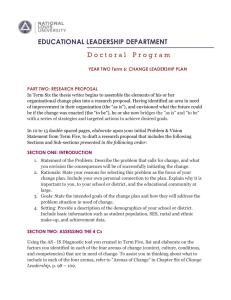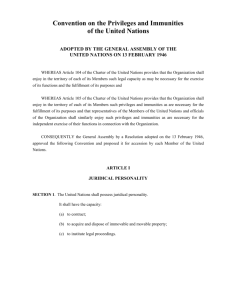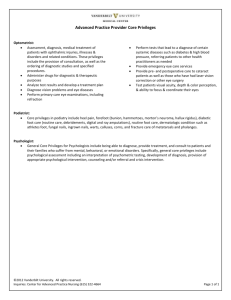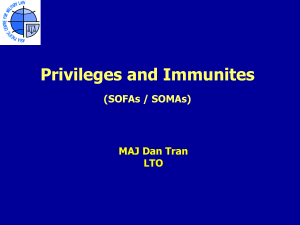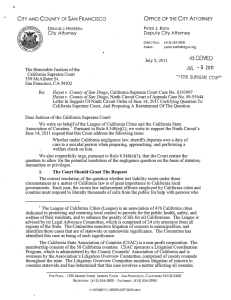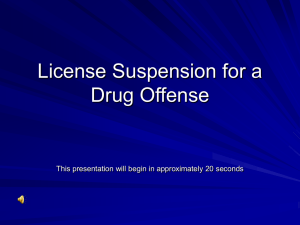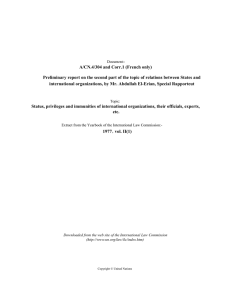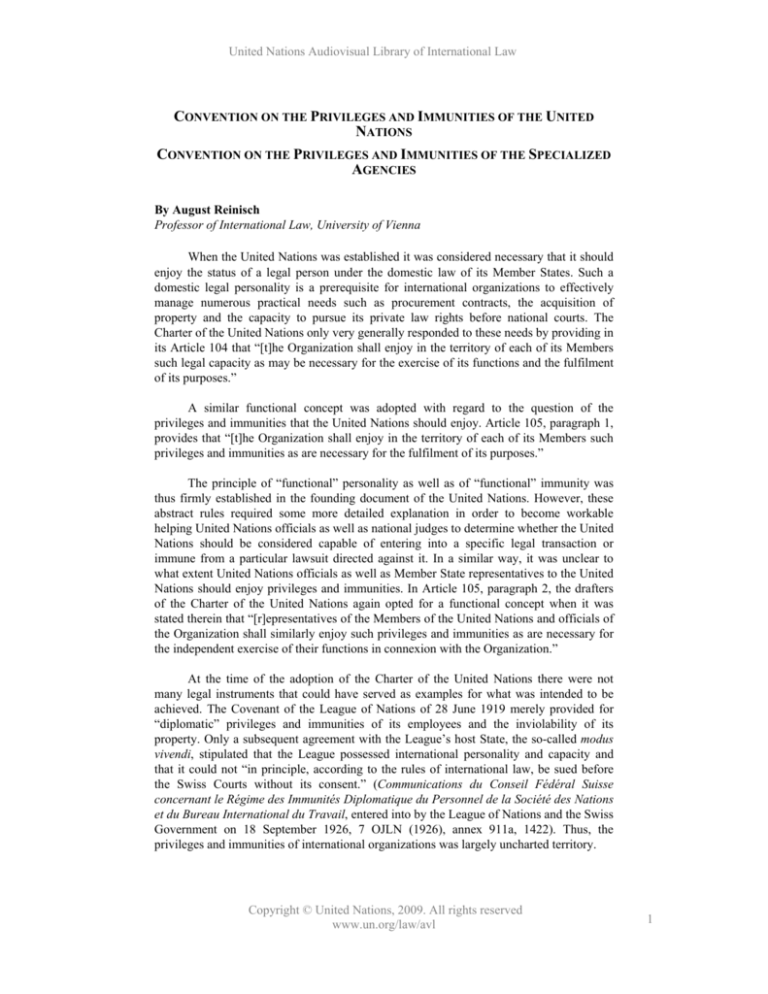
United Nations Audiovisual Library of International Law
CONVENTION ON THE PRIVILEGES AND IMMUNITIES OF THE UNITED
NATIONS
CONVENTION ON THE PRIVILEGES AND IMMUNITIES OF THE SPECIALIZED
AGENCIES
By August Reinisch
Professor of International Law, University of Vienna
When the United Nations was established it was considered necessary that it should
enjoy the status of a legal person under the domestic law of its Member States. Such a
domestic legal personality is a prerequisite for international organizations to effectively
manage numerous practical needs such as procurement contracts, the acquisition of
property and the capacity to pursue its private law rights before national courts. The
Charter of the United Nations only very generally responded to these needs by providing in
its Article 104 that “[t]he Organization shall enjoy in the territory of each of its Members
such legal capacity as may be necessary for the exercise of its functions and the fulfilment
of its purposes.”
A similar functional concept was adopted with regard to the question of the
privileges and immunities that the United Nations should enjoy. Article 105, paragraph 1,
provides that “[t]he Organization shall enjoy in the territory of each of its Members such
privileges and immunities as are necessary for the fulfilment of its purposes.”
The principle of “functional” personality as well as of “functional” immunity was
thus firmly established in the founding document of the United Nations. However, these
abstract rules required some more detailed explanation in order to become workable
helping United Nations officials as well as national judges to determine whether the United
Nations should be considered capable of entering into a specific legal transaction or
immune from a particular lawsuit directed against it. In a similar way, it was unclear to
what extent United Nations officials as well as Member State representatives to the United
Nations should enjoy privileges and immunities. In Article 105, paragraph 2, the drafters
of the Charter of the United Nations again opted for a functional concept when it was
stated therein that “[r]epresentatives of the Members of the United Nations and officials of
the Organization shall similarly enjoy such privileges and immunities as are necessary for
the independent exercise of their functions in connexion with the Organization.”
At the time of the adoption of the Charter of the United Nations there were not
many legal instruments that could have served as examples for what was intended to be
achieved. The Covenant of the League of Nations of 28 June 1919 merely provided for
“diplomatic” privileges and immunities of its employees and the inviolability of its
property. Only a subsequent agreement with the League’s host State, the so-called modus
vivendi, stipulated that the League possessed international personality and capacity and
that it could not “in principle, according to the rules of international law, be sued before
the Swiss Courts without its consent.” (Communications du Conseil Fédéral Suisse
concernant le Régime des Immunités Diplomatique du Personnel de la Société des Nations
et du Bureau International du Travail, entered into by the League of Nations and the Swiss
Government on 18 September 1926, 7 OJLN (1926), annex 911a, 1422). Thus, the
privileges and immunities of international organizations was largely uncharted territory.
Copyright © United Nations, 2009. All rights reserved
www.un.org/law/avl
1
United Nations Audiovisual Library of International Law
It was against this background that the Convention on the Privileges and Immunities
of the United Nations, frequently referred to as the “General Convention”, was negotiated
and adopted in the immediate aftermath of the establishment of the United Nations. As
provided for in Article 105, paragraph 3, of the Charter of the United Nations, it was
adopted by the General Assembly at its first session on 13 February 1946 (resolution 22 A
(I)) on the basis of a draft of the United Nations Preparatory Commission. It entered into
force on 17 September 1946 and was registered with the Secretary-General on 14
December 1946. It was one of the first treaties to be published in the United Nations Treaty
Series.
The General Convention specifies the notion of “functional” personality and
immunity of the United Nations and contains detailed provisions on the privileges and
immunities enjoyed by United Nations officials and Member State representatives.
Because of the high level of precision of the Convention’s articles they are considered
directly applicable or self-executing in many national legal systems. That means that
national courts may directly rely on them without the need of national implementing
legislation.
In article I, section 1, the “functional” personality of the United Nations is defined
as “juridical personality” encompassing the specific capacity: “(a) to contract; (b) to
acquire and dispose of immovable and movable property; (c) to institute legal
proceedings.” This provision clarifies that the United Nations should be able to enter into
day-to-day operations governed by private law.
The Convention’s core provision with regard to immunity from jurisdiction is found
in article II, section 2, which runs as follows: “The United Nations, its property and assets
wherever located and by whomsoever held, shall enjoy immunity from every form of legal
process except insofar as in any particular case it has expressly waived its immunity. It is,
however, understood that no waiver of immunity shall extend to any measure of
execution.” The resulting “absolute” immunity from suit of the United Nations has been
largely respected in most countries, though some national courts have tried to limit the
Organization’s scope of immunity along the initially envisaged “functional” immunity. In
practice, this has also sometimes led to the application of restrictive State immunity
principles denying immunity for “commercial” activities.
The de facto “absolute” immunity of the United Nations is mitigated by the fact that
article VIII, section 29, of the Convention requires the United Nations to “make provisions
for appropriate modes of settlement of: (a) disputes arising out of contracts or other
disputes of a private law character to which the United Nations is a party”. The General
Convention’s obligation to provide for alternative dispute settlement in case of the
Organization’s immunity from legal process can be regarded as an acknowledgment of the
right of access to court as contained in all major human rights instruments.
Private law contracts entered into by the United Nations regularly contain arbitration
clauses. In the case of tort claims, such as those resulting from harm suffered as a result of
peacekeeping operations or vehicular accidents, the United Nations usually agrees on
similar forms of dispute resolution. Staff disputes within the United Nations are settled by
an internal mechanism in the form of the United Nations Administrative Tribunal,
established in 1949 (General Assembly resolution 351 A (IV) of 9 December 1949). In
2009, this system will undergo a major reform leading to the establishment of a two-tier
Copyright © United Nations, 2009. All rights reserved
www.un.org/law/avl
2
United Nations Audiovisual Library of International Law
judicial system with a United Nations Dispute Tribunal and a United Nations Appeals
Tribunal.
In addition to immunity from suit, the General Convention provides for the
“inviolability” of United Nations premises and property which basically means that they
are exempted from any search, requisition, confiscation, or other forms of executive,
administrative, judicial or legislative interference. The same inviolability applies to the
archives of the United Nations.
The most important “privileges” conferred upon the United Nations by the General
Convention are fiscal ones. Most significantly, article II, section 7, exempts the United
Nations from all direct taxes as well as from customs duties and quotas concerning goods
for the United Nations’ official use. With regard to indirect taxes, the Convention merely
provides that in case of “important purchases for official use” the State concerned will
make appropriate administrative arrangements for tax reimbursement.
The General Convention further contains privileges and immunities for three
categories of persons crucial for the work of the Organization: 1) representatives of
Member States; 2) United Nations officials; and 3) experts on missions for the United
Nations. While Member State representatives enjoy modified diplomatic privileges and
immunities, United Nations officials, i.e. permanently employed staff members, enjoy
“functional” immunity which is defined in article V, section 18 (a), as immunity “from
legal process in respect of words spoken or written and all acts performed by them in their
official capacity.” Article V, section 20, stresses that “[p]rivileges and immunities are
granted to officials in the interests of the United Nations and not for the personal benefit of
the individuals themselves” and that the Secretary-General has to waive the immunity of
United Nations officials where it would “impede the course of justice and can be waived
without prejudice to the interests of the United Nations.” In addition to jurisdictional
immunity, United Nations officials are tax exempt with regard to their salary received from
the United Nations and enjoy a number of other fiscal, travel and residence privileges.
Only the Secretary-General, Under-Secretaries-General and Assistant Secretaries-General
enjoy full diplomatic privileges and immunities.
As opposed to United Nations officials, experts on missions for the United Nations,
like members of the International Law Commission, Special Rapporteurs, or members of
United Nations peacekeeping operations, serve under a temporary and specific mandate.
They also enjoy certain functionally limited privileges and immunities pursuant to article
VI of the General Convention.
The General Convention has had a major impact on the development of subsequent
treaties dealing with privileges and immunities of international organizations. Already on
21 November 1947, the General Assembly approved the Convention on the Privileges and
Immunities of the Specialized Agencies. It entered into force on 2 December 1948 and
applies to those United Nations related international organizations that have entered into
special relationship agreements with the United Nations pursuant to Article 63 of the
Charter, such as the International Civil Aviation Organization, the World Health
Organization, the Food and Agriculture Organization, the United Nations Educational,
Scientific and Cultural Organization, the International Monetary Fund, the International
Bank for Reconstruction and Development, and others. The so-called Special Convention
Copyright © United Nations, 2009. All rights reserved
www.un.org/law/avl
3
United Nations Audiovisual Library of International Law
contains roughly the same provisions on privileges and immunities as the General
Convention.
Examples of similar privileges and immunities treaties are the General Agreement
on Privileges and Immunities of the Council of Europe, 1949, and the Agreement on
Privileges and Immunities of the Organization of American States, 1949. Numerous
“headquarters” or “seat agreements” have also been influenced by the General Convention.
Related Materials
A. Legal Instruments
Covenant of the League of Nations of 28 June 1919 (LEG 341.123 L434: Edition
embodying the Amendment of Article 6, in force as from the 13th August 1924, and the
Amendments of Articles 12, 13 and 15, in force as from the 26th September 1924).
Communications du Conseil Fédéral Suisse concernant le Régime des Immunités
Diplomatique du Personnel de la Société des Nations et du Bureau International du
Travail, entered into by the League of Nations and the Swiss Government on 18 September
1926, 7 Official Journal of the League of Nations (1926), annex 911a, 1422.
Agreement on Privileges and Immunities of the Organization of American States,
Washington, 15 May 1949, United Nations, Treaty Series, vol. 1438, p. 79.
General Agreement on Privileges and Immunities of the Council of Europe, Paris, 2
September 1949, (ETS No. 2), United Nations, Treaty Series, vol. 250, p. 14.
B. Documents
General Assembly resolution 22 A (I) of 13 February 1946 (Privileges and Immunities of
the United Nations).
General Assembly resolution 351 A (IV) of 9 December 1949 (Establishment of a United
Nations Administrative Tribunal).
C. Doctrine
K. Ahluwalia, The Legal Status, Privileges and Immunities of the Specialized Agencies of
the United Nations and Certain Other International Organizations, M. Nijhoff, The
Hague, 1964.
P. H. F. Bekker, The Legal Position of Intergovernmental Organizations: A Functional
Necessity Analysis of Their Legal Status and Immunities, M. Nijhoff, Dordrecht, Boston
and London, 1994.
W. C. Jenks, International Immunities, Stevens & Sons Ltd., London, 1961.
A. Reinisch, International Organizations Before National Courts, Cambridge University
Press, Cambridge, 2000.
Copyright © United Nations, 2009. All rights reserved
www.un.org/law/avl
4

